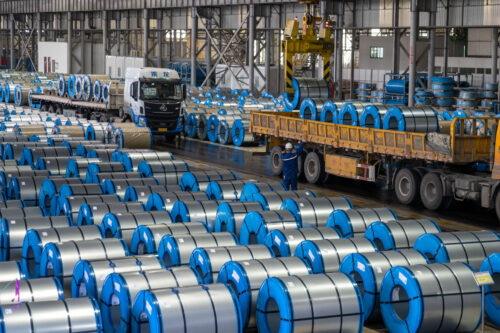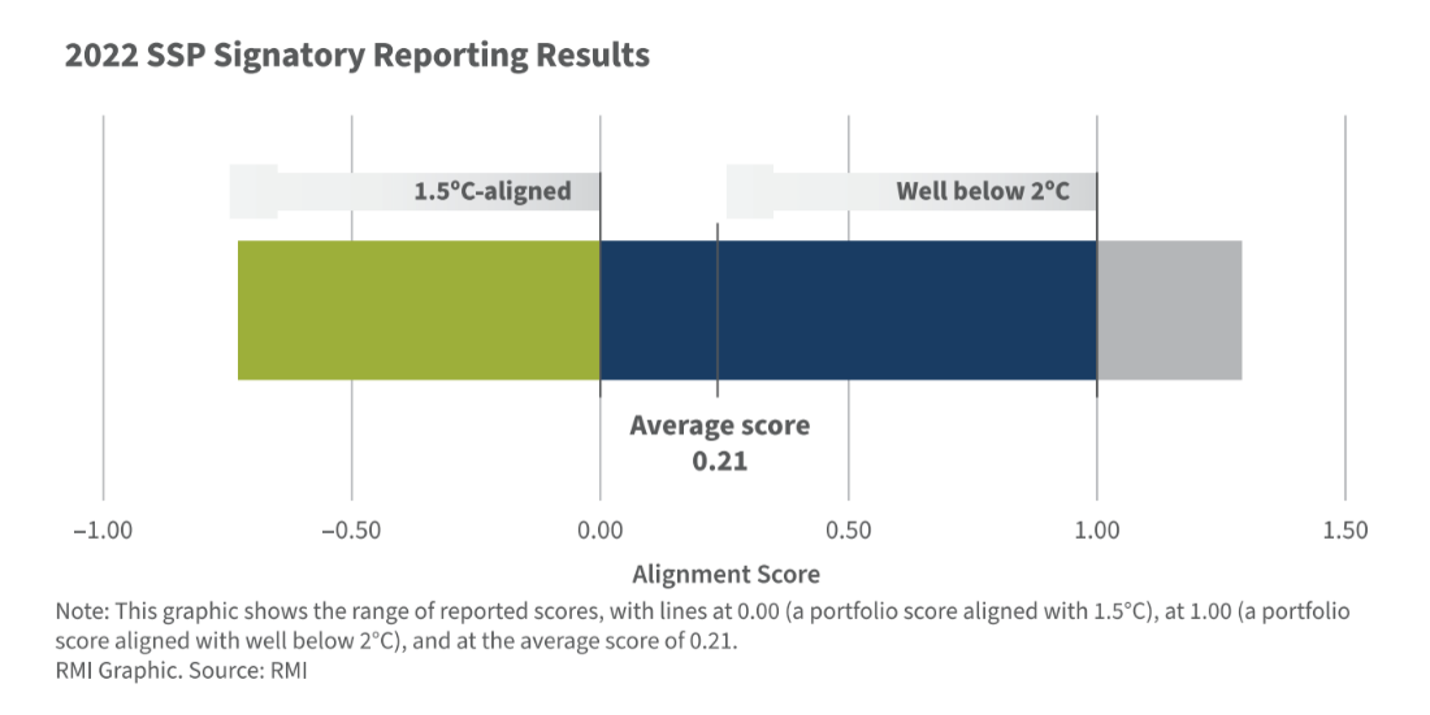A worker is lifting finished steel coils at a workshop in the Hefei Circular Economy Demonstration Park in Hefei, China, on February 18, 2024. (Photo by Costfoto/NurPhoto via Getty Images)

Steel Sector Financiers Disclose Climate Alignment for the First Time — and There’s More Work to Do
Findings from the first Sustainable STEEL Principles report
The journey towards a more sustainable steel sector has reached a new milestone with the publication of the first Sustainable STEEL Principles (SSP) Annual Report. A joint effort led by RMI in collaboration with six pioneering banks — Citi, Crédit Agricole CIB, ING, Société Générale, Standard Chartered, and UniCredit — the report represents a groundbreaking step towards transparency in reporting the climate alignment of steel lending portfolios. With steel production accounting for 8 percent of global emissions, and demand expected to rise a further 30 percent by 2050, this report sets a new standard for disclosing steel portfolio emissions, promoting accountability, and driving the sector towards decarbonization goals.
Positive steps toward low-carbon steel production, but the sector remains misaligned
The steel sector is at a critical juncture in its journey toward decarbonization. The first steps to net-zero steelmaking are being taken by industry, and coordinated efforts encompassing producers, financial institutions, and policymakers are taking place across the full value chain:
- Hydrogen-based direct-reduced iron (DRI) established itself as a core technology for the sector’s transition, with H2 Green Steel serving as a prominent example of its application. Under the leadership of five commercial banks, including half of the signatories to the SSP (ING, Société Générale, and UniCredit), H2 Green Steel signed definitive debt financing agreements for €4.2 billion for the world’s first large-scale green steel plant.
- The Breakthrough Agenda, launched at the UN Climate Change Conference in November 2018, now has the backing of countries representing more than 50 percent of global emissions. The initiative’s “priority actions” include a commitment to clearly define near-zero-emissions steel to help direct billions of dollars in investments, procurement, and trade to this effort.
- Key legislation like the European Union’s Green Deal Industrial Plan and the Carbon Border Adjustment Mechanism, along with a US commitment of $5.8 billion under the Inflation Reduction Act for industrial decarbonization projects will provide critical support for the development of pioneering low-carbon projects.
Despite these positive developments, however, the current pace of transformation falls short of the efforts necessary to meet global climate targets. Approximately two-thirds of all announced steelmaking projects worldwide are not on track to be aligned with 1.5°C and fall into the high-emissions category. Applying the SSP alignment methodology to the steel sector as a whole shows that, on average, the sector is misaligned with both the SPP’s 1.5°C and well-below 2°C benchmarks.
As major providers of financing to the steel sector, banks can support and enable change. The SSP Annual Report serves as a cornerstone for these efforts, offering an unprecedented level of insight into the financial sector’s engagement with steel producers. With the publication of this report, major lenders to the steel sector are robustly and transparently disclosing where they are on their decarbonization journey.
Report shows positive alignment, more work to be done in emerging markets
- One-third of SSP signatories are aligned with the 1.5°C benchmark, while another half are aligned with the well-below 2°C benchmark.
- All SSP signatories demonstrated greater alignment with climate goals compared to the broader steel sector.
- More misaligned scores can be attributed to increased exposure to emerging markets and blast furnace operations — areas where transformation is both challenging and essential, and where the signatories’ engagement is most needed.

SSP methodology enables more robust individual bank target-setting and strategies
Beyond the disclosure of climate alignment metrics, the SSP framework equips banks with the insights necessary to set impactful individual targets and to engage with clients to support the decarbonization of the steel sector. This year’s report sheds light on how banks are leveraging insights gained from applying the SSP to better define and pursue their own individual goals and strategies.
All signatories have leveraged the SSP methodology to set independent robust, sector-specific targets for 2030 and 2050, and have further applied the SSP to develop internal sector strategies. For example:
- Several banks outline their efforts to mobilize and engage with existing clients toward achieving individually determined short- and long-term decarbonization goals. Société Générale, for instance, highlights that it “aims to (1) support its clients that will face important challenges to transition their assets in line with the [SSP’s IEA and Mission Possible Partnership] scenarios in the short term and (2) develop dedicated financing for brown-to-green and low-carbon steel projects.”
- Other banks highlight their commitment to financing projects that advance the development of low-carbon compatible technologies, including gas- or hydrogen-based DRI facilities, carbon capture, scrap-based steelmaking, and innovative techniques such as the direct smelting of iron ore. UniCredit, for example, “looks forward to implementing dedicated financing among other current initiatives that aim to support steel clients on their journey to decarbonization.”
- Finally, banks report that they have embedded the commitments made under the SSP in their internal governance, ensuring that decarbonization goals are clearly defined, progress is regularly assessed, and strategies are adjusted as needed. For example, Crédit Agricole S.A., explains that “[To reach our decarbonization target in the steel sector, we plan to] implement governance at the Group’s highest level to define and follow through with our commitments, with quarterly monitoring.”
For more on the goals and strategies of the SSP signatories, read the Annual Report here.
The steel sector is at a critical juncture that demands contributions from every corner of industry, finance, and policy. As the SSP Annual Report underscores, the steel industry urgently needs to accelerate its transition if it is to align with the global goal of limiting temperature increases to 1.5°C.
The efforts of the six SSP signatories represent just the first steps taken on the much longer journey towards this goal. Nevertheless, these first steps are crucial, setting a precedent for the proactive role that financial institutions can take to support their industrial clients in their transition. It is now up to the broader sector to embrace a similarly ambitious blueprint for change and rise to the challenges ahead.
A note on the principles: While SSP signatories commit to assessing the alignment of their steel sector lending portfolios against net-zero benchmarks, banks individually set net-zero targets and independently develop the strategies to reach them. In adherence with anti-trust legislation, there is no coordination between the banks around those strategies.